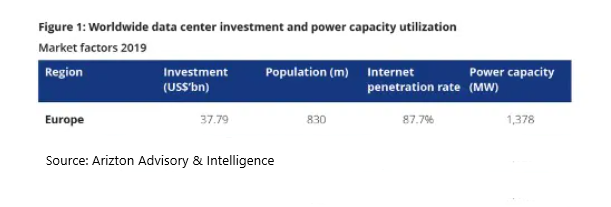The Data Centre growth has been driven by company awareness of the benefits that cloud services can offer, the pressure to provide even more secure IT environments, along with setup of local data centres across the region.
Consequently and according to a joint survey by PwC and the Urban Land Institute "Emerging Trends in Real Estate Europe 2021", this sector is deemed as the most attractive one and JLL has also indicated within "Data Center Outlook Year-End 2020" that the total YTD returns for the sector of Data Center was 17,2% (as of November 2020), a figure which is far from returns applicable to retail, office, resorts or residential sectors.

Indeed, more and more companies are outsourcing their data operations to third-party providers that specialize in data centre operations. Colocation data centres are popular and provide physical space, power, and cooling systems for servers and connections to local communication networks. Investment activity has grown on several fronts and it has increased on a speculative basis where cloud demand has been strongest, secondary markets where cloud demand has increased, and new international markets.
Besides the core markets of the UK, Germany, the Netherlands and France, some countries are seeing extensive new investment, such as Switzerland, Poland or Ireland. The European Data Centre market is undergoing a boom in new facility build-outs, with over 70 projects underway in 12 countries from 2021 onwards, totalling 851,000 m2, increases from under 10% in Sweden up to over 100% in Ireland.
We noted that the EMEA area reached a record demand of 701 MW for 2020, according to DC Byte, an increase of 10 % compared to the previous year.
Profiting from the digitalization of the economy, industry of data centres are cropping up all over Europe and France has a role to play with Paris among the most attractive cities for Data centre investors alongside Dublin, Stockholm, or Amsterdam. Because of the COVID-19 pandemic and the increase of remote working, the market is booming and expected to grow even faster than predicted. The data centre are now facing cybersecurity and availability challenges. Thankfully, the cities are adjusting their local urban planning regulations to encourage the construction of those facilities and value such installations. Due to countless challenges data centers are now facing, it is crucial for them to adapt to their new customers' needs and define a short, middle and especially long-term development strategy by either building new facilities or collaborating with complementary business service providers. Public entities shall also take into account the fact that such an industry is booming, implying high demand of power's reservation that may cause shortage, an increase of power connection at a rapid pace and fiber access.
Apart from needing a work permit after consultation of the Prefect, those installations are usually classified for the protection of the environment which is why the installation of the data centre would be easier in industrial zones to facilitate the issuance of the requested facilities to operate such a business and the administrative use of the site would need to be consistent with this specific type of building.
The construction of such facilities would request prior and various authorizations regarding notably environmental impacts. Thus, any implementation of a data center shall be well-anticipated (minimum 12 to 18 months of instruction in France) and the power capacity would be crucial, as well as the cost of access to electricity which differ in each country. The attention shall also be specially drawn on the potential damages of the activity to neighbours, as it had been flagged in 2015 (Interxion) specifically for noise nuisance. In preliminary contracts, a developer would notably have to set up conditions precedent the approval and get clearance with all authorisations needed including the issuance of final permits/facilities, power capacity agreement, etc. The most crucial point would be the power capacity of the building rather that the number of square meters of the building.
Finally, the renewable sources of global energy used are also a challenge for such buildings, in order to generate renewable energy, be able to provide green solutions to customers, help them achieve their goals of renewable energy and criteria of sustainability.



